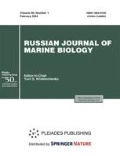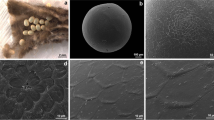Abstract
Data on the larval development of Quasitetrastemma stimpsoni and Q. nigrifrons are presented. In both species, fertilization is external; the development passes through a free-swimming larval stage, the “hidden larva.” The larva has three pairs of eyes. After settling, the eyes of the second pair fuse with eyes of the first pair or are completely reduced. The basis and stylets are formed in 7–8 days after fertilization. Larvae of Q. stimpsoni settle on day 9–10 after fertilization; and Q. nigrifrons, on day 7–8.
Similar content being viewed by others
References
Lebedinskii, Ya.N., Nablyudeniya and istoriei razvitiya nemertin (Observations on the History of Development of Nemerteans), Zap. Novoros. ob-va estestvoispytat., 1898, vol. 22, pp. 1–124.
Maslakova, V. and Malakhov, C., Nemertiny otryada Hoplonemertini imeyut skrytuyu lichinku (Nemerteans of the Order Hoplonemertini possess a hidden larva), Dokl. RAN, 1999, vol. 366, no. 6, pp. 849–852.
Chernyshev, A.V., Lichinki nemertin semeistva Ototyphlonemertidae v zalive Petra Velikogo Yaponskogo morya (Larvae of Nemerteans of the Family Ototyphlonemertidae in Peter the Great Bay of the Sea of Japan), Biologiya morya, 2000, vol. 26, no. 1, pp. 50–52.
Chernyshev, A.V., The System of Higher Taxa of the Enoplan Nemerteans (Nemertea, Enopla), Biologiya morya, 2003, vol. 29,no 5, pp. 299–306.
Chernyshev, A.V., Two New genera of nemertean worms of the family Tetrastemmatidae (Nemertea: Monostilifera), Zoosyst. Ross., 2004, vol. 12, no. 2, pp. 151–156.
Egan, E.A. and Anderson, D.T., The Reproduction of the Entozoic Nemertean Gononemertes australiensis Gibson (Nemertea: Hoplonemertea: Monostylifera) Gonads, Gametes, Embryonic Development and Larval Development, Austral. J. Mar. Freshwat. Res., 1979, vol. 30, pp. 661–681.
Gibson, R., A New Species of Commensal Hoplonemertean from Australia, Zool. J. Linn. Soc., 1974, vol. 55, pp. 247–266.
Iwata, F., Studies on the Comparative Embryology of Nemerteans with Special Reference to Their Interrelationships, Publ. Akkeshi Mar. Biol. St., 1960, no. 10, pp. 1–51.
Norenburg, J.L., Redescription of a Brooding Nemertine, Cyanophthalma obscura (Schultze) gen. et comb. n., with Observations on its Biology and Discussion of the Species of Prostomatella and Related Taxa, Zool. Scr., 1986, vol. 15, pp. 275–293.
Norenburg, J.L. and Stricker, S.A., Phylum Nemertea, Atlas of Marine Invertebrate Larvae, Academic Press, 2002, pp. 163–177.
Stricker, S.A., The Stylet Apparatus of Monostiliferous Hoplonemerteans, Amer. Zool., 1985, vol. 25, pp. 87–97.
Author information
Authors and Affiliations
Corresponding author
Additional information
Original Russian Text © A.V. Chernyshev, 2008, published in Biologiya Morya.
Rights and permissions
About this article
Cite this article
Chernyshev, A.V. Larval development of nemerteans of the genus Quasitetrastemma (Nemertea: Monostilifera). Russ J Mar Biol 34, 258–262 (2008). https://doi.org/10.1134/S1063074008040081
Accepted:
Published:
Issue Date:
DOI: https://doi.org/10.1134/S1063074008040081




